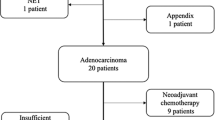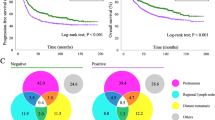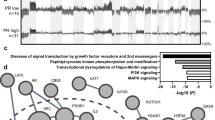Abstract
Background
Low-grade serous ovarian and peritoneal cancer (LGSC) is a rare disease and few data on the clinical and genomic landscape have been published.
Methods
A retrospective analysis of patients diagnosed with LGSC between 1996 and 2019 was conducted in MITO centers. Objective Response Rate (ORR) to treatments, progression-free survival (PFS) and overall survival (OS) were assessed. Additionally, the tumor molecular profile of 56 patients was evaluated using the Next Generation Sequencing (NGS) FoundationOne CDX (Foundation Medicine®).
Results
A total of 128 patients with complete clinical data and pathologically confirmed diagnosis of LGSC were identified. ORR to first and subsequent therapies were 23.7% and 33.7%, respectively. PFS was 43.9 months (95% CI:32.4–53.1) and OS was 105.4 months (95% CI: 82.7–not reached). The most common gene alterations were: KRAS (n = 12, 21%), CDKN2A/B (n = 11, 20%), NRAS (n = 8, 14%), FANCA (n = 8, 14%), NF1 (n = 7, 13%) and BRAF (n = 6, 11%). Unexpectedly, pathogenetic BRCA1 (n = 2, 4%), BRCA2 (n = 1, 2%) and PALB2 (n = 1, 2%) mutations were found.
Conclusions
MITO 22 suggests that LGSC is an heterogenous disease for both its clinical behavior in response to standard therapies and its molecular alterations. Future prospective studies should test treatments according to biological and molecular tumor’s characteristics.
Clinical trial registration
This study is registered under NCT02408536 on ClinicalTrials.gov.
This is a preview of subscription content, access via your institution
Access options
Subscribe to this journal
Receive 24 print issues and online access
$259.00 per year
only $10.79 per issue
Buy this article
- Purchase on Springer Link
- Instant access to full article PDF
Prices may be subject to local taxes which are calculated during checkout


Similar content being viewed by others
Data availability
The datasets used and analyzed during the current study are available from the corresponding authors on reasonable request.
References
Slomovitz B, Gourley C, Carey MS, Malpica A, Shih IM, Huntsman D, et al. Low-grade serous ovarian cancer: state of the science. Gynecol Oncol. 2020;156:715–25.
Gockley A, Melamed A, Bregar AJ, Clemmer JT, Birrer M, Schorge JO, et al. Outcomes of women with high-grade and low-grade advanced-stage serous epithelial ovarian cancer. Obstet Gynecol. 2017;129:439–47.
Grabowski JP, Harter P, Heitz F, Pujade-Lauraine E, Reuss A, Kristensen G, et al. Operability and chemotherapy responsiveness in advanced low-grade serous ovarian cancer. An analysis of the AGO Study Group metadatabase. Gynecol Oncol. 2016;140:457–62.
Gershenson DM, Sun CC, Bodurka D, Coleman RL, Lu KH, Sood AK, et al. Recurrent low-grade serous ovarian carcinoma is relatively chemoresistant. Gynecol Oncol. 2009;114:48–52.
Monk BJ, Grisham RN, Banerjee S, Kalbacher E, Mirza MR, Romero I, et al. MILO/ENGOT-ov11: binimetinib versus physician’s choice chemotherapy in recurrent or persistent low-grade serous carcinomas of the ovary, fallopian tube, or primary peritoneum. J Clin Oncol. 2020;38:3753–62.
Singer G, Stöhr R, Cope L, Dehari R, Hartmann A, Cao DF, et al. Patterns of p53 mutations separate ovarian serous borderline tumors and low- and high-grade carcinomas and provide support for a new model of ovarian carcinogenesis: a mutational analysis with immunohistochemical correlation. Am J Surg Pathol. 2005;29:218–24.
Van Nieuwenhuysen E, Busschaert P, Laenen A, Moerman P, Han SN, Neven P, et al. Loss of 1p36.33 frequent in low-grade serous ovarian cancer. Neoplasia. 2019;21:582–90.
Hunter SM, Anglesio MS, Ryland GL, Sharma R, Chiew YE, Rowley SM, et al. Molecular profiling of low grade serous ovarian tumours identifies novel candidate driver genes. Oncotarget. 2015;6:37663–77.
Rambau PF, Vierkant RA, Intermaggio MP, Kelemen LE, Goodman MT, Herpel E, et al. Association of p16 expression with prognosis varies across ovarian carcinoma histotypes: an Ovarian Tumor Tissue Analysis Consortium study. J Pathol Clin Res. 2018;4:250–61.
Singer G, Oldt R, Cohen Y, Wang BG, Sidransky D, Kurman RJ, et al. Mutations in BRAF and KRAS characterize the development of low-grade ovarian serous carcinoma. J Natl Cancer Inst. 2003;95:484–6.
Wong KK, Tsang YTM, Deavers MT, Mok SC, Zu Z, Sun C, et al. BRAF mutation is rare in advanced-stage low-grade ovarian serous carcinomas. Am J Pathol. 2010;177:1611–7.
Emmanuel C, Chiew Y-E, George J, Etemadmoghadam D, Anglesio MS, Sharma R, et al. Genomic classification of serous ovarian cancer with adjacent borderline differentiates RAS pathway and TP53-mutant tumors and identifies NRAS as an oncogenic driver. Clin Cancer Res. 2014;20:6618–30.
Cheasley D, Nigam A, Zethoven M, Hunter S, Etemadmoghadam D, Semple T, et al. Genomic analysis of low-grade serous ovarian carcinoma to identify key drivers and therapeutic vulnerabilities. J Pathol. 2021;253:41–54.
Gershenson DM, Miller A, Brady WE, Paul J, Carty K, Rodgers W, et al. Trametinib versus standard of care in patients with recurrent low-grade serous ovarian cancer (GOG 281/LOGS): an international, randomised, open-label, multicentre, phase 2/3 trial. Lancet. 2022;399(Feb):541–53.
Monk BJ, Grisham RN, Banerjee S, Kalbacher E, Mirza MR, Romero I, et al. MILO/ENGOT-ov11: binimetinib versus physician’s choice chemotherapy in recurrent or persistent low-grade serous carcinomas of the ovary, fallopian tube, or primary peritoneum. J Clin Oncol. 2020;38(Nov):3753–62.
Farley J, Brady WE, Vathipadiekal V, Lankes HA, Coleman R, Morgan MA, et al. Selumetinib in women with recurrent low-grade serous carcinoma of the ovary or peritoneum: an open-label, single-arm, phase 2 study. Lancet Oncol. 2013;14:134–40.
Escobar J, Klimowicz AC, Dean M, Chu P, Nation JG, Nelson GS, et al. Quantification of ER/PR expression in ovarian low-grade serous carcinoma. Gynecol Oncol. 2013;128:371–6.
Buttarelli M, Mascilini F, Zannoni GF, Ciucci A, Martinelli E, Filippetti F, et al. Hormone receptor expression profile of low-grade serous ovarian cancers. Gynecol Oncol. 2017;145:352–60.
Gershenson DM, Sun CC, Iyer RB, Malpica AL, Kavanagh JJ, Bodurka DC, et al. Hormonal therapy for recurrent low-grade serous carcinoma of the ovary or peritoneum. Gynecol Oncol. 2012;125:661–6.
Gershenson DM, Bodurka DC, Coleman RL, Lu KH, Malpica A, Sun CC. Hormonal maintenance therapy for women with low-grade serous cancer of the ovary or peritoneum. J Clin Oncol. 2017;35:1103–11.
Tang M, O’Connell RL, Amant F, Beale P, McNally O, Sjoquist KM, et al. PARAGON: a Phase II study of anastrozole in patients with estrogen receptor-positive recurrent/metastatic low-grade ovarian cancers and serous borderline ovarian tumors. Gynecol Oncol. 2019;154:531–8.
Zhang X, Devins K, Ko EM, Reyes MC, Simpkins F, Drapkin R, et al. Mutational spectrum in clinically aggressive low-grade serous carcinoma/serous borderline tumors of the ovary-Clinical significance of BRCA2 gene variants in genomically stable tumors. Gynecol Oncol. 2021;161:762–8.
Malpica A, Deavers MT, Lu K, Bodurka DC, Atkinson EN, Gershenson DM, et al. Grading ovarian serous carcinoma using a two-tier system. Am J Surg Pathol. 2004;28:496–504.
Prat J.FIGO Committee on Gynecologic Oncology Staging classification for cancer of the ovary, fallopian tube, and peritoneum. Int J Gynaecol Obstet. 2014;124:1–5.
Calzolari A, Napolitano M, Bravo E. Review of the Italian current legislation on research biobanking activities on the eve of the participation of national biobanks’ network in the legal consortium BBMRI-ERIC. Biopreserv Biobank. 2013;11:124–8.
Gershenson DM, Sun CC, Wong KK. Impact of mutational status on survival in low-grade serous carcinoma of the ovary or peritoneum. Br J Cancer. 2015;113:1254–8.
Schmeler KM, Sun CC, Malpica A, Deavers MT, Bodurka DC, Gershenson DM. Low-grade serous primary peritoneal carcinoma. Gynecol Oncol. 2011;121:482–6.
Schmeler KM, Sun CC, Bodurka DC, Deavers MT, Malpica A, Coleman RL, et al. Neoadjuvant chemotherapy for low-grade `or peritoneum. Gynecol Oncol. 2008;108:510–4.
Dalton HJ, Fleming ND, Sun CC, Bhosale P, Schmeler KM, Gershenson DM. Activity of bevacizumab-containing regimens in recurrent low-grade serous ovarian or peritoneal cancer: a single institution experience. Gynecol Oncol. 2017;145:37–40.
Grisham RN, Iyer G, Sala E, Zhou Q, Iasonos A, DeLair D, et al. Bevacizumab shows activity in patients with low-grade serous ovarian and primary peritoneal cancer. Int J Gynecol Cancer. 2014;24:1010–4.
Kaldawy A, Segev Y, Lavie O, Auslender R, Sopik V, Narod SA. Low-grade serous ovarian cancer: a review. Gynecol Oncol. 2016;143:433–8.
Grisham RN, Vergote I, Banerjee SN, Drill EN, Fabbro M, Mirza MR, et al. Molecular results and potential biomarkers identified from MILO/ENGOT-ov11 phase 3 study of binimetinib versus physicians’ choice of chemotherapy (PCC) in recurrent low-grade serous ovarian cancer (LGSOC). J Clin Oncol. 2021;39:5519–5519.
Dong Y, Walsh MD, McGuckin MA, Gabrielli BG, Cummings MC, Wright RG, et al. Increased expression of cyclin-dependent kinase inhibitor 2 (CDKN2A) gene product P16INK4A in ovarian cancer is associated with progression and unfavorable prognosis. Int J Cancer. 1997;74:57–63.
Acknowledgements
The authors are grateful to Gelsomina Iovane, Margherita Tambaro and Angela Maria Trujillo for data management.
Funding
A specific funding was received for this work. The research leading to these results has received funding from AIRC under IG 2016 – ID. 18921 and IG 2021 – ID. 25932 projects – P.I. SP and CO-2018–12367051 (Ministero della Salute) P.I SP; Ricerca Corrente grant M2/7 from Ministero della Salute to DC, Ricerca Corrente from Ministero della Salute to SP.
Author information
Authors and Affiliations
Contributions
SP conceived the study; LM, DC and SP contributed to methodology; All authors collected the data; DC, GFZ, NSL were responsible for the assessment of the primary FFPE tumor tissue, including the estimation of tumor cellularity; LM and LA interpreted and analyzed the data; LM wrote the manuscript; LA, LM, DC and SP played a key role in interpreting the results and revised the article critically for important intellectual content; SP supervised the project and agreed to be accountable for all aspects of the work in ensuring that questions related to the accuracy or integrity of any part of the work are appropriately investigated and resolved; All authors reviewed and approved the final version of the manuscript.
Corresponding author
Ethics declarations
Competing interests
DL reports research funding from Clovis, GSK and MSD, personal interests with AstraZeneca, Clovis Oncology, GSK, Pharmamar, MSD and financial interests with Clovis, Genmab, GSK, MSD. Board of Directors, GCIG (Gynecologic Cancer Inter Group). FR reports honoraria from GSK, Pharmamar, Clovis, MSD and Roche. VS reports honoraria from GSK, PharmaMar, Roche, MSD, EISAI, Clovis, Oncology, AstraZeneca. FP reports honoraria for educational and advisory activity from Incyte, GSK, Eli Lilly, Ipsen, Astellas, AstraZeneca, Roche, BMS, Bayer, Clovis, Pierre Fabre and grants for clinical trials to his institution from Roche, Astra Zeneca, Pfizer, MSD, Bayer, Incyte Taiho, Janssen, Exelixis, Ailenor, Daiichi Sankyo. GS reports research support from MSD and honoraria from Clovis Oncology. Consultant for Tesaro and Johnson & Johnson. SP reports honoraria from AstraZeneca, MSD, Roche, Pfizer, Clovis, GSK, Pharmamar and research funding from MSD, Roche, Astrazeneca and Pfizer. LM, DC, MB, LA, NSL, GC, SG, GV, CP, AS, DR, MDS, VC, FF, GFZ, VL, VG, CC, VT, MD, VDV, SS and DP have nothing to disclose.
Ethics approval and consent to participate
This study was approved by the ethics committee of the National Cancer Institute of Naples (22/14 OSS) and the ethics committees of the participating centers, and it was conducted in accordance with the Declaration of Helsinki. The study participants gave written informed consent.
Additional information
Publisher’s note Springer Nature remains neutral with regard to jurisdictional claims in published maps and institutional affiliations.
Supplementary information
Rights and permissions
About this article
Cite this article
Musacchio, L., Califano, D., Bartoletti, M. et al. Clinical characteristics and molecular aspects of low-grade serous ovarian and peritoneal cancer: a multicenter, observational, retrospective analysis of MITO Group (MITO 22). Br J Cancer 127, 1479–1486 (2022). https://doi.org/10.1038/s41416-022-01897-1
Received:
Revised:
Accepted:
Published:
Issue Date:
DOI: https://doi.org/10.1038/s41416-022-01897-1



